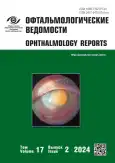The uveitis–glaucoma–hyphema syndrome. Part 1. Pathogenesis, clinical features, diagnosis
- 作者: Belov D.F.1,2, Nikolaenko V.P.1,2, Shuvaev D.A.2, Potemkin V.V.1,3, Khripun K.V.1, Terekhova I.V.1
-
隶属关系:
- Saint Petersburg Multifield Hospital No. 2
- Saint Petersburg State University
- Academican I.P. Pavlov First St. Petersburg State Medical University
- 期: 卷 17, 编号 2 (2024)
- 页面: 31-39
- 栏目: Original study articles
- URL: https://journals.rcsi.science/ov/article/view/262998
- DOI: https://doi.org/10.17816/OV626405
- ID: 262998
如何引用文章
详细
BACKGROUND: The uveitis–glaucoma–hyphema (UGH) syndrome was first described in 1978 as a complication of anterior chamber polymethyl methacrylate intraocular lenses implantation. Introduction into practice of foldable intraocular lenses with intracapsular fixation has reduced the incidence of UGH. However, this complication still occurs today, especially with extracapsular intraocular lens fixation.
AIM: The aim of this study is to describe “uveitis–glaucoma–hyphema” syndrome pathogenesis, clinical features, and diagnosis.
MATERIAL AND METHODS: A retrospective analysis of medical data for 2017–2021 identified 100 patients (101 eyes) diagnosed with UGH syndrome, they made up the study group. Complaints, medical history, biomicroscopy, visual acuity and intraocular pressure were assessed. 37 patients underwent anterior segment ultrasound biomicroscopy using the Accutome UBM Plus (USA).
RESULTS: The occurrence of UGH syndrome is at least 0.19%. The leading UGH syndrome risk factor was intraocular lens material. In 49% of cases these were AcrySof hydrophobic intraocular lenses. The second UGH risk factor was extracapsular (mixed and sulcus) intraocular lens fixation, occurring, according to ultrasound biomicroscopy, in 54 and 19% of cases, respectively. The most significant diagnostic UGH sign was hyphema (93%). Ocular hypertension was detected in 66%, and uveitis in 57% of cases.
CONCLUSIONS: The main UGH syndrome manifestations are hyphema and iris transillumination after phacoemulsification complicated by posterior capsule rupture with extracapsular hydrophobic intraocular lens fixation. The most informative instrumental method to assess intraocular lens position is ultrasound biomicroscopy.
作者简介
Dmitrii Belov
Saint Petersburg Multifield Hospital No. 2; Saint Petersburg State University
编辑信件的主要联系方式.
Email: belovd1990@gmail.com
ORCID iD: 0000-0003-0776-4065
SPIN 代码: 2380-2273
MD, Cand. Sci. (Medicine)
俄罗斯联邦, Saint Petersburg; Saint PetersburgVadim Nikolaenko
Saint Petersburg Multifield Hospital No. 2; Saint Petersburg State University
Email: dr.Nikolaenko@mail.ru
ORCID iD: 0000-0002-6393-1289
SPIN 代码: 4906-2542
MD, Dr. Sci. (Medicine)
俄罗斯联邦, Saint Petersburg; Saint PetersburgDmitrii Shuvaev
Saint Petersburg State University
Email: dima_201107@mail.ru
ORCID iD: 0009-0003-5983-6232
俄罗斯联邦, Saint Petersburg
Vitaliy Potemkin
Saint Petersburg Multifield Hospital No. 2; Academican I.P. Pavlov First St. Petersburg State Medical University
Email: potem@inbox.ru
ORCID iD: 0000-0001-7807-9036
SPIN 代码: 3132-9163
MD, Cand. Sci. (Medicine)
俄罗斯联邦, Saint Petersburg; Saint PetersburgKirill Khripun
Saint Petersburg Multifield Hospital No. 2
Email: kirdoc@mail.ru
ORCID iD: 0009-0005-5960-3222
MD, Cand. Sci. (Medicine)
俄罗斯联邦, Saint PetersburgIrina Terekhova
Saint Petersburg Multifield Hospital No. 2
Email: irterehova@yandex.ru
ORCID iD: 0000-0002-8666-1541
俄罗斯联邦, Saint Petersburg
参考
- Ellingson FT. The uveitis–glaucoma–hyphema syndrome associated with the Mark VIII anterior chamber lens implant. J Am Intraocul Implant Soc. 1978;4(2):50–53. doi: 10.1016/s0146-2776(78)80054-8
- Badakere SV, Senthil S, Turaga K, Garg P. Uveitis–glaucoma–hyphaema syndrome with in-the-bag placement of intraocular lens. BMJ Case Rep. 2016;19:2016:bcr2015213745. doi: 10.1136/bcr-2015-213745
- Foroozan R, Tabas JG, Moster ML. Recurrent microhyphema despite intracapsular fixation of a posterior chamber intraocular lens. J Cataract Refract Surg. 2003;29(8):1632–1635. doi: 10.1016/s0886-3350(03)00122-6
- Siepser SB, Kline OR Jr. Scanning electron microscopy of removed intraocular lenses. J Am Intraocul Implant Soc. 1983;9(2): 176–183. doi: 10.1016/s0146-2776(83)80034-2
- Armonaite L. Behndig A. Seventy-one cases of uveitis–glaucoma–hyphaema syndrome. Acta Ophthalmol. 2021;99(1):69–74. doi: 10.1111/aos.14477
- Piette S, Canlas OA, Tran HV, et al. Ultrasound biomicroscopy in uveitis–glaucoma–hyphema syndrome. Am J Ophthalmol. 2002;133(6):839–841. doi: 10.1016/s0002-9394(02)01386-7
- Zemba M, Camburu G. Uveitis–glaucoma–hyphaema syndrome. General review. Rom J Ophthalmol. 2017;61(1):11–17. doi: 10.22336/rjo.2017.3
- Magargal LE, Goldberg RE, Uram M et al. Recurrent microhyphema in the pseudophakic eye. Ophthalmology. 1983;90(10):1231–1234. doi: 10.1016/s0161-6420(83)34396-7
- Yusef YuN, Yusef SN, Ivanov MN et al. Evolution of IOL exchange. Part 1. Development of methods for IOL exchange. The Russian Annals of Ophthalmology. 2020;136(5):248–253. (In Russ.) EDN: HPTJZV doi: 10.17116/oftalma2020136052248
- Accorinti M, Saturno MC, Paroli MP et al. Uveitis–glaucoma–hyphema syndrome: clinical features and differential diagnosis. Ocul Immunol Inflamm. 2022;30(6):1408–1413. doi: 10.1080/09273948.2021.1881563
- Durr GM, Ahmed IIK. Intraocular lens complications: decentration, uveitis–glaucoma–hyphema syndrome, opacification, and refractive surprises. Ophthalmology. 2021;128(11):e186–e194. doi: 10.1016/j.ophtha.2020.07.004
- Potemkin VV, Astakhov SYu, Varganova TS et al. Long-term results of late “in-the-bag” IOL dislocation surgery. Ophthalmology Reports. 2023;16(2):17–27. EDN: WUGKPD doi: 10.17816/OV321819
- Tong L, Hou AH, Wong TT. Altered expression level of inflammation-related genes and long-term changes in ocular surface after trabeculectomy, a prospective cohort study. Ocul Surf. 2018;16(4): 441–447. doi: 10.1016/j.jtos.2018.06.005
- Quigley HA, Broman AT. The number of people with glaucoma worldwide in 2010 and 2020. Br J Ophthalmol. 2006;90(3):262–267. doi: 10.1136/bjo.2005.081224
- Potyomkin VV, Ageeva EV. Zonular instability in patients with pseudoexfoliative syndrome: the analysis of 1000 consecutive phacoemulsifications. Ophthalmology Reports. 2018;11(1):41–46. doi: 10.17816/OV11141-46
- Wintle R, Austin M. Pigment dispersion with elevated intraocular pressure after AcrySof intraocular lens implantation in the ciliary sulcus. J Cataract Refract Surg. 2001;27(4):642–644. doi: 10.1016/s0886-3350(00)00792-6
- Yang J, Qiu X, Cai L et al. Uveitis–glaucoma–hyphema syndrome associated with an in-the-bag square-edge intraocular lens. Precis Clin Med. 2019;2(4):283–287. doi: 10.1093/pcmedi/pbz026
- Ti SE, Yang YN, Lang SS, Chee SP. A 5-year audit of cataract surgery outcomes after posterior capsule rupture and risk factors affecting visual acuity. Am J Ophthalmol. 2014;157(1):180–185.e1. doi: 10.1016/j.ajo.2013.08.022
- Lippera M, Nicolosi C, Vannozzi L et al. The role of anterior segment optical coherence tomography in uveitis–glaucoma–hyphema syndrome. Eur J Ophthalmol. 2022;32(4):2211–2218. doi: 10.1177/11206721211063738
补充文件










